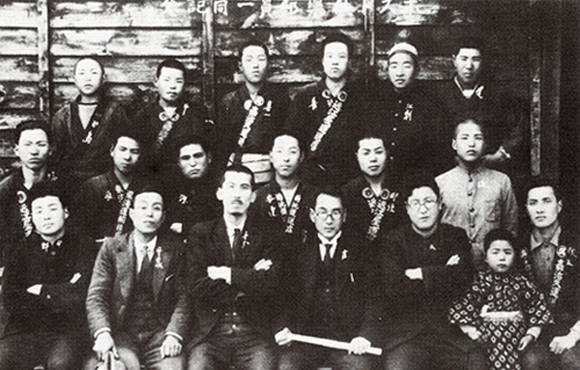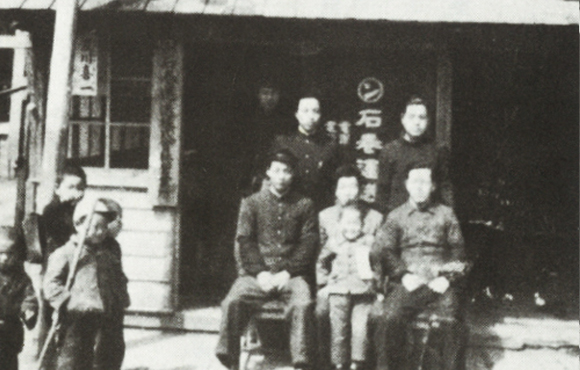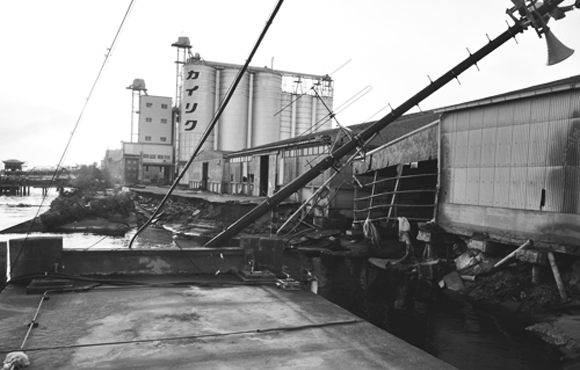HISTORY
Before Incorporation
Leading Shipping Agency/Cargo Broker at the Busiest Port in East Japan
Ishinomaki used to be just a tiny port town located at the mouth of the Kitakami River.
Around 400 years ago, the port began to flourish as a loading port of rice. It actually started with excavation of the Kitakami River, which was undertaken in the early modern period (1620s, early Edo period) by a local flood control expert (Kawamura Magobei, 1575–1648) by the order of the region’s feudal lord (Date Masamune, 1567–1636).
By the late 1770s, more than 50 ships were regularly calling at the port to load local rice to Edo, a former capital name of Tokyo.
In its heyday, local rice shipped out from Ishinomaki to Edo annually was as much as 200,000 koku, which is about 30,000 ton in a modern unit of measure. Ishinomaki was allegedly the businest port in eastern Japan in those days.
The port was full of shipping agents and cargo brokers, who were busy loading and unloading cargo, catering for seafarers, and providing accommodations. One of those agents/brokers was Kajikyu, the founder of Kairiku.

Wartime Economy and Monopoly
Ishinomaki Station opened its doors in 1912, when the Sendai Light Railway began operating between Kogota and Ishinomaki. This facilitated transport of seafood from Ishinomaki, Watanoha and the Oshika Peninsula by rail, which used to be transported by sea. This change attracted entrepreneurs, who started small freight forwarding businesses around Ishinomaki Station.
Kajikyu, which was running business as a shipping agent/cargo broker, seized the opportunity to set up a new business under the name Kajikyu Unsoten (Kajikyu Forwarder), laying the foundations for Kairiku.
Later, as the Japanese government acted to clamp down on the establishment of numerous small forwarders, Kajikyu joined forces with two other forwarders to establish Ishinomaki Joint Transportation Company. However, the Japanese government tightened its control over wartime economy; in particular, the government reduced the number of forwarders per station to only one designated by the government. Subsequently, the company merged with Nippon Express to become the Nippon Express Ishinomaki Branch. It was on August 1, 1945, just before the end of World War II.
Small Company with One Cart and Three Carriages
The war came to an end. A remnant of the wartime controlled economy, however, continued to affect the postwar society.
To survive, many people began engaging in black markets for selling what they made. As a free market gradually returned, people began to question the government control of economy and monopoly. Especially, they began to criticize the monopoly of forwarding business, which was dominated by the only one forwarder designated by the government in the community.
The year 1947 saw the foundation in Ishinomaki of one company with a straightforward name called Nizukuri Unpansha (The Packing and Transport Company). It was a very small company with only ¥50,000 in capital, nine employees, one cart, and three carriages. It was launched by Sato Hisashi, who would later become the second president of Kairiku.
Growing with Local Support
Local Economy Hit Hard by Disruption in Seafood Distribution
The steady growth of fishing industry helped fish processing industry, which was (and still is) a main industry in Ishinomaki, flourish. However, many accidents occurred, disrupting transportation of processed seafood. People feared that this would severely affect the local economy. To address this issue, the young Packing and Transport Company’s staff frantically traveled through Ishinomaki to help factories package processed seafood, transport them by carts to the station, in order to ship them out as soon as possible. They did this to help the local industry; not for profit. This was how they built trust among the fish processing industry.
The one-forwarder-per-station monopoly was ended on February 1,1950, and long-awaited privatization of the forwarding industry began. Sato Hisashi, President of the Packing and Transport Company, began preparing for the establishment of a new forwarding company, and in August of the same year he acquired a forwarder license at the stations of Ishinomaki and Rikuzen-inai. With the support of many locals including the seafood processing industry in the community, he established Ishinomaki Unso Co., Ltd. (Ishinomaki Transport Co., Ltd.) on September 30, 1950.

Realizing Multimodal Transport
Ishinomaki Port opened as an industrial port in 1967, eventually growing into one of the major logistics hubs in Tohoku as well as an international trade port. The addition of air freight handling facilities to Sendai Airport in 1993 also helped realize seamless domestic-global transport.
After its launch in 1950, Ishinomaki Unso changed its name in 1967 to Ishinomaki Kairiku Unso Co., Ltd. before changing the name once again to Kairiku Co., Ltd. in 1992. In pace with the development of the local community and Miyagi Prefecture, the company gradually expanded its business to railway transport, then terminal operation, and finally air cargo transport. Now, Kairiku has grown into a company that can offer cost-effective multimodal transport solutions.
Overcoming the Disaster
“The Company Will Survive.
No One Will Lose a Job.”
An earthquake struck the region at 14:46 on March 11, 2011. The hypocenter was off the Sanriku Coast near the Oshika Peninsula in Miyagi Prefecture. Subsequently, a massive tsunami struck Japan's Pacific coast. Soma in Fukushima Prefecture and Miyako in Iwate Prefecture were hit by a wave of more than 9.3 meters and 8.5 meters high respectively. The tsunami inundated almost entire central Ishinomaki, with the exception of higher elevations. Damage was particularly severe in Kahoku, Ogatsu, Kitakami and Oshika. The earthquake and tsunami claimed the precious lives of 3,278 people (as of April 5, 2017).
Kairiku's two headquarters in Sendai and Ishinomaki were both inundated by the tsunami up to the ceiling of the first floor. The tsunami devastated offices, warehouses, loading and unloading facilities, and heavy machinery. Kairiku’s office at Sendai Airport was lost in a fire subsequent to the earthquake. The company was fighting for its very survival. Sato Isao, the company's president, made a solemn promise: “The company will survive. No one will lose a job. Let’s move on. Rebuild our community.”
Rebuilding Customer Network and Local Economy
“The company will survive. No one will lose a job.” The determination by the president, on the following day of the earthquake and tsunami when the future was utterly uncertain, encouraged employees. They were all united under the same goal: rebuild the community as soon as possible. They manually cleared debris, and reinforced damaged walls of offices and warehouses with plywood. It was OK as long as it kept out the wind and rain. At the end of May, just two months after the disaster, Kairiku was once again accepting cargo, delivering emergency relief supplies, and working to rebuild the community.
Years have passed since the earthquake and tsunami stuck the region, but there is still a long way to go. Kairiku has been and will be a local transport partner to the community. We are committed to contribute toward helping out customers and reconstructing and further developing the local community.

“Kairiku, Leading Logistics Company in Tohoku”
Business in Tohoku for More than 100 Years
Kairiku has been in business in Tohoku for about 70 years from the incorporation of Ishinomaki Unso, the predecessor of Kairiku, and more than 100 years from the foundation of Kajikyu Unsoten, a small family business founded by the ancestor. Over time, many things—the company's name, staff, and business areas—have changed, but there is something that remains unchanged: hardworking and honest people.
We are not an elegant and high-class company, but we are hardworking and honest. Perhaps this is why we have many longstanding customers for more than a century.
Small but Significant
Our goal is to be an exciting and successful company. It may sound a little too simple and obvious, but we want to be a team that remains high-spirited even in the face of economic downturns and natural disasters. We want to be a company that our hardworking team can be proud of. Our goal is not simply to expand our business, but rather to be an integral part of the community. We want to be a small but significant company.
As the saying goes in Japan, “Sansho, or Japanese pepper, is tiny but very spicy.” We want to be like sansho, and someday we want to hear people say, “There is a small but significant company called Kairiku in Tohoku.”